|
Stairway to Heaven: Pilgrimage
to Manakamana I had been wanting to plan a picnic for a
long time. In Nepal, they are a national pastime. Families plan them
around trips to temples. Youth groups fundraise and then use the
proceeds to plan picnics in far off locales, often centering also on
temples and holy spots set in scenic surroundings.
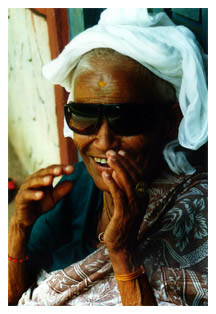 I became obsessed
with the idea of getting Haji, our 84 year old widowed grandmother to Manakamana
Temple, something she had always dreamed of doing but wasn't a
possibility until very recently. I became obsessed
with the idea of getting Haji, our 84 year old widowed grandmother to Manakamana
Temple, something she had always dreamed of doing but wasn't a
possibility until very recently.
Haji, short for Hajuraama which translates as
respected mother, trying on a pair of sunglasses.
Manakamana Temple is located between Kathmandu and Pokhara and a grueling 4-5 hour trek straight up.
The entire path ranges from uneven rock-steps to dirt incline, but all
of it, ever upward. As a day trip, it must be undertaken early in the
morning before the sun begins to take its toll.
I had done the trek last year along with the multitude
of pilgrims, laden with chickens, pigeons and goats, sometimes leading,
sometimes dragging them up the mountain. Manakamana one of the most
popular temples in Nepal for animal sacrifices. The ruling goddess,
Bhagwati is believed to grant wishes in exchange for prayer and animal
sacrifices. Hence, the parade of animals. For those interested in making
the trek, take the Gorkha turnoff at Aaboo Kheireni along the
Pokhara-Ktm Prithivi Highway and head towards the bridge over the
Marsyangdi River. Just before the bridge, look for the Manakamana Hotel
and the path is just behind and below the hotel and leads across a
suspension pathway and up the mountain.
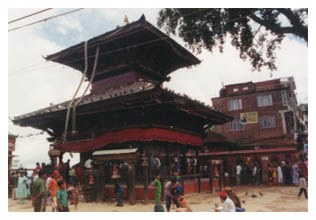
People try at least once in their lifetime, if not more
often to make the pilgrimage to Manakanama and make a sacrifice to the
goddess. But Haji in her advanced age, had about given up hope of making
the journey on her shaky legs. But that all changed with the Swiss. Some
might imagine Nepal as an Asian Switzerland, with their rugged and
challenging landscape. But Nepal lacks much of the technology that the
Swiss use to master the topography until now. A joint venture between a
Nepali and a Swiss company designed, funded and built the new Manakamana
cable car, a first in the kingdom of Nepal. And it was going to give
Haji a second chance to get up there.
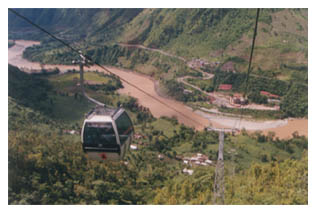
Manakamana Cable Car overlooking the Marsyangdi
River and the Kathmandu-Pokhara Prithivi Highway east of Mugling
So, I tried to plan a picnic...
So much easier said than done. First, how to get
everyone there. As a family, we number thirteen people, five children
and of course, a goat, for what would be trip to Manakamana be without a
sacrifice. Among us, we had to take a van, a taxi and motorbike to get
us all there. The starting point of the cable car was a good two hours
from Pokhara.We spend the whole week before talking about the food,
thinking of elaborate spreads of curries, meat, and rice pudding (a
nepali favorite.) But when it came down to, we barely managed the goat.
We didn't have a pot big enough to cook for everyone. We got lazy and
didn't bring any vegis. We finally packed up just a bag of rice and few
spices. They assured me it that there were places that we could get our
goat cooked and we didn't need to bring the whole kitchen. I did smuggle
two tins of Pringles, a crowd-pleasing favorite. Prakash was chosen to
go and pick the he-goat. He brought it home and we tied it up outside
and fed it leaves. When we went to bed that night, we brought it in the
house and secured it in the hallway. We tried to sleep through the
incessant bleating but it near impossible, it was so loud. In the
morning, the hallway was sticky and covered with little poo pellets. I
kept hurrying everyone along, but eighteen people all seem to move at
their own paces, clogging up the bathroom and blowing our early start.
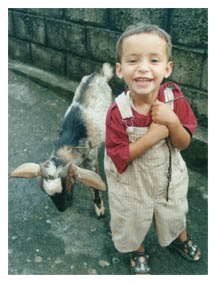 Babu
helping us load up. Babu
helping us load up.
When we were all finally ready, we loaded up. Krishna
Dhai (elder brother) drove the taxi with Haji, Aama (mother), Baba
(father) and Ganga Didi (elder sister) It was kinda like the adult table
at holiday dinners. The van was driven by the brother in law of Bauju
(elder brother's wife) and Bauju and her sister were in the front with
him. Me, Sarita and Radha (middle and youngest sister) were in the
middle and all five kids in the back, ranging in age from 3-12. Then in
the very back in that small space behind the last row of seats, was our
bleating goat who was nesting anew in a pile of pellets. Devi and
Prakash (middle and youngest brother) were on the motorbike. And so our
caravan set out. Sarita smuggled a tape of Prakash's and we played it at
high volume in the van. The kids were jamming in the back. Bouncing
along to the musical stylings of the Venga Boys, we all sang at the top
of the lungs "We're going to eat Pizza!" I guess it was the
Nepali version of going to Ibiza.
We must have bounced a little too much. The van got
quieter. And next thing I knew, the rear window was open, and Sunil was
tossing his dhal bhatties out the window, only it didn't really make it
out the window. Then the smell must have got the best of Sarita and
Radha, cause they barely got the window open in time on both sides of
me. We pulled into Dumre, a hour from Pokhara. Aama got out of the taxi
and started bargaining for fruit. Krishna borrowed a jug and began
washing down both sides of the van, pouring water into
the window sill to wash out the chunks that were lodged in the cracks.
Aama came back with a load of fruit- bananas, mangoes and grapes. We had
some when we stopped for tea a short time later at the poet Banu Bhakta
Memorial, and everyone was careful to order black tea to keep pure for
the upcoming puja worship. We finally made it there.
At the ticket window, Devi bought all the tickets,
including the special goat fare. Aama was admanant that I shouldn't pay
the special foreign supplement, a hefty $10 USD, but no one paid me the
slightest attention, in my kurta, Nepali adornments and my Mongolian
features and complexion. We entered into the main staging area for the
cable car. Haji looked a bit apprehensive, as the cable cars swung into
the station, never topping but circling around slowly while people
entered and exited. Our goat was tagged and set aside. In tune with
local needs, every tenth car was special livestock car, an open metal
pen. He'd be going after us and we'd wait for him at the top. We watched
a few go up, the goats peeking their heads over the railing and never
ceasing their awful bleating. We took three cars and began the twenty
minute journey up.

Sarita, myself and Radha on the cable car to
Manakamana
When we got to the top and exited the cable cars, there
was a big commotion. In the livestock car in front of us, a goat had
died. The family was making a big scene, claiming that they had given
the cable car company a live goat and was now getting back a dead one.
It was a highly inauspicious start to their day of worship to say the
least. Not only could they not offer a dead goat to the goddess, but
they couldn't even eat it. It was a total waste, and they had to scrape
together some money to buy another goat at sky high 'tourist' rates.
Everyone knows you don't buy your goat at the temple, but always bring
one from home! After listening to them demanding some partial compensation from the
cable car company, our goat final arrived and we took a picture to
celebrate the moment.

 At the top, we made our way over to the temple area.
Aama immediately set about preparing for the puja. She purchased a
couple of leaf bowls filled with the requisite offerings: a whole
coconut, flowers, prasad (sweet candy kernals) cotton and candle
wicks, incense sticks, rolled up prayers, tikka powder, rice and colored cords. At the top, we made our way over to the temple area.
Aama immediately set about preparing for the puja. She purchased a
couple of leaf bowls filled with the requisite offerings: a whole
coconut, flowers, prasad (sweet candy kernals) cotton and candle
wicks, incense sticks, rolled up prayers, tikka powder, rice and colored cords.
On
sale throughout the temple area is the ready-made puja platter, in case
you didn't bring your own.
We set up
shop under the large tree in the courtyard area, removing our shoes,
rolling up our pant legs, and getting ready. Prakash brought over our
goat. Aama began chanting, praying that our goat might be an acceptable
and pleasing sacrifice to the gods. She then offered homage to the
divinity within him, blessing him with tikka powder on his forehead,
placing flowers behind his ears and wrapping a red prayer cloth around his
neck. 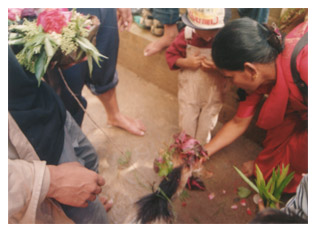
We
each stepped up and repeated this act until the goat's entire head was
red with powder and he wore a halo of flowers. The guys then led him
around the the back of the temple. There, a priest stood in front of a
small hollow structure. Crowds of people kept surging forward with their
sacrifices. One at a time families stepped up to the elevated platform
and made their offerings. The priest, barefoot and splattered in blood,
accepted the offering with a number of short prayers and with a swift
motion, brought a sharp sickle down in a flash and severed his head
cleanly. 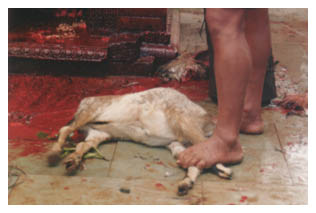
The
ground under the goat was soaked with blood. As it drained into a small
hole in front of the a small alter, it stained the ground a brilliant
and remarkable shade of red. The heads are customarily offered to the
diety, and then tossed to the side. And with that the ceremony was
ended, only to start yet again with the next family in the long line. 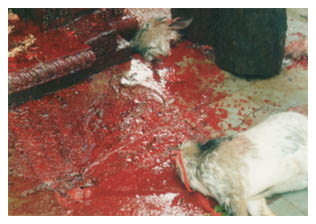
With
that completed, we prepared to actually enter the temple and worship.
Around the perimeter of the temple was hundreds of small bowls, to be
filled with oil and candle wicks and lighted or to arrange burning
incense. 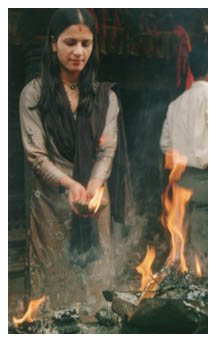 With
our leaf bowls of offerings in hand, we encircled the temple, lighting
incense and the candle wicks and saying prayers and asking for the
blessings of the gods. With
our leaf bowls of offerings in hand, we encircled the temple, lighting
incense and the candle wicks and saying prayers and asking for the
blessings of the gods.
Sarita making an offering 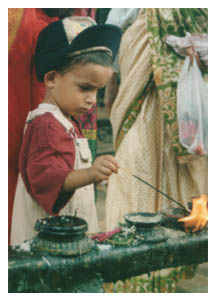
Evan
Babu joined in, lighting his incense from some burning wicks and
enjoying all the commotion and frenzy of Manakamana The
line to enter the inner sanctuary of the temple and receive a blessing
from the priest was long. We waited patiently as it snaked its way
slowly forward, clutching our offerings and flowers which were wilting
in the hot midday sun. Finally reaching the doorway, we stepped through
a small squat doorway, crouching over so as not to bang our heads and
entered the dim sanctum. The air was thick with incense, and it was hard
to adjust my eyes. Two priests sat against the wall to our left. They
sat crouched up against what appeared to be a small alter. People
followed the line around to both sides of the priests. Stepping up to
the priests and handing over your offering, they requested your name and
what your desire. Chanting Sanskritic mantras, they blessed you with a
smear of sticky red tika and rice paste on your forehead and some
flowers on your head, and you were on your way. Back outside in the
bright sunlight, we posed for numerous photos in a gay celebratory mood. 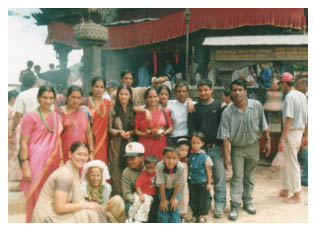
All
of us, Haji is second from left with her white widow's scarf 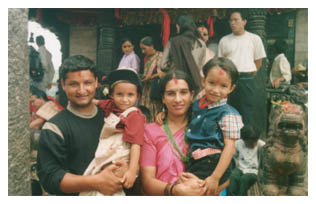
Krishna
Dhai, Bauji, his wife and their kids Nanu and Babu Haji
came around to each and every one of us and gave us blessings, asking
the gods to favor and protect us, and smearing rice and tikka on our
forehead. This is an important aspect of Nepali cultural interaction and
the sharing of blessings and forehead tikas is a valued and respected
way of respecting and blessing one another. Everyone began blessing each
other, sharing special words and prayers until all our foreheads were
covered in the red paste and rice. 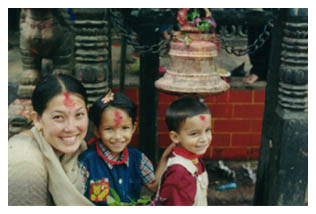
Me
with my two favorites kids in the world, Nanu (Manisha Kumari) and Babu
(Manoj Kumar) tikad and blissed out We tied our protection cords around
our necks, both the fat red cheesecloth one which would be removed in a
few days as well as the smaller, long lasting shiny cords finished with
a small medallion featuring pictures of the temple, various Gods such as
Shiva or Ganesha, or revered figures such as Buddha, the Dalai Lama, Sai
Baba or the King. We ate the sickly sweet prasad, crunching down on the
white kernals of hard suger. Aama broke up the coconuts and we munched
on the succulent white meat paired with the prasad for sweetness. 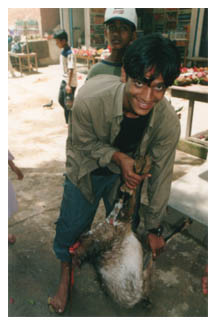 Prakash
picked up the goat and with Krishna took him down the street to the area
where men and women worked over a huge bonfire. For a price, they first
roasted the goat over the fire until all the hair was singed off and the
stomach had bloated into a stiff bubble. Then they carved it up into
managable pieces, cutting through the bone more effectively than the
knives we had brought and returned to us a bucket filled to the brim. Prakash
picked up the goat and with Krishna took him down the street to the area
where men and women worked over a huge bonfire. For a price, they first
roasted the goat over the fire until all the hair was singed off and the
stomach had bloated into a stiff bubble. Then they carved it up into
managable pieces, cutting through the bone more effectively than the
knives we had brought and returned to us a bucket filled to the brim.
Krishna
had assured us that we would be able to find a place, one of the many
lodges surrounding the temple that would cook our goat for us for a
price. But as we walked around asking, we were repeatedly turned down.
Whatever price a lodge owner could fetch for cooking a goat would be
less than what he could make serving us food to other paying customers.
It seemed pretty bleak, and we kept moving further and further away from
the temple. Finally, a ways away from the temple, we found a lodge that
was pretty empty, rather surprising given the pleasant outdoor garden
that overlooked the valley. We found the owner and with much cajoling,
we managed to convince him, not to cook our goat for us, but allow us to
use his kitchen for a fee and the promise to drink lots of cokes. We
settled in, everyone diving for the Pringles and relaxing on the long
table under the main canopy. I brought out my other surprise, an
enormous bag of M&M's and we sat around contentedly snacking on
Pringles and chocolate. Then we turned to the matter of the real food.
The guys took the bucket out back and began cleaning and carving the
meat. Bauju and her sister and brother in law took over the kitchen and
started the rice cooking, an enormous bucket full in the largest pot the
lodge owned. I watch the cleaning process for awhile... 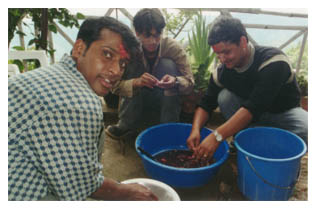
Devi,
Prasad and Krishna cleaning the various innards Yeeee...nothing
is left to waste let's say. A good amount of time is devoted to the
intestines, washing them out and such. Also, the stomach, and all the
organs are thoroughly cleaned and chopped into bite size morsels. Then,
all the internals are fried with onions and chilies and cooked to a
tasty snack. Finally, the muscle meat was cooked,
bone-in into a delicious thick mutton curry and served over rice. For
the few vegitarians in the crowd (Haji and Sarita) we bought some
vegetable curry from the lodge, and armed with 18 cokes, sprites and the
crowd-pleasing fantas, we ate with gusto and of course our hands. 
good
grub...and nothing like a coke to wash it down! The
ride home was a far cry from the trip up. Everyone save for the drivers
slept, tired, full and satisfied by the picnic well-done, a picnic to
make Nepalis proud. And I have to think of replacing Manakamana with
something else for Haji to dream about, lest she get any ideas about
dying happy. I am now thinking, Aama in America... back
to Meet the Sapkotas |
